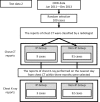Screening of anticancer drugs to detect drug-induced interstitial pneumonia using the accumulated data in the electronic medical record
- PMID: 30009034
- PMCID: PMC6043691
- DOI: 10.1002/prp2.421
Screening of anticancer drugs to detect drug-induced interstitial pneumonia using the accumulated data in the electronic medical record
Abstract
Because drug-induced interstitial pneumonia (DIP) is a serious adverse drug reaction, its quantitative risk with individual medications should be taken into due consideration when selecting a medicine. We developed an algorithm to detect DIP using medical record data accumulated in a hospital. Chest computed tomography (CT) is mainly used for the diagnosis of IP, and chest X-ray reports, KL-6, and SP-D values are used to support the diagnosis. The presence of IP in the reports was assessed by a method using natural language-processing, in which IP was estimated according to the product of the likelihood ratio of characteristic keywords in each report. The sensitivity and the specificity of the method for chest CT reports were 0.92 and 0.97, while those for chest X-ray reports were 0.83 and 1, respectively. The occurrence of DIP was estimated by the patterns of presence of IP before, during, and after the administration of the target medicine. The occurrence rate of DIP in cases administered Gefitinib; Methotrexate (MTX); Tegafur, Gimeracil, and Oteracil potassium (TS-1); and Tegafur and Uracil (UTF) was 6.0%, 2.3%, 1.4%, and 0.7%, respectively. The estimated DIP cases were checked by having the medical records independently reviewed by medical doctors. By chart review, the positive predictive values of DIP against Gefitinib, MTX, TS-1, and UFT were 69.2%, 44.4%, 58.6%, and 77.8%, respectively. Although the cases extracted by this method included some that did not have DIP, this method can estimate the relative risk of DIP between medicines.
Keywords: adverse drug reaction; electronic medical record; imaging report; interstitial pneumonia; natural language processing.
Figures


Similar articles
-
[Tegafur gimeracil oteracil potassium capsule induced acute interstitial lung disease: a case report].Zhongguo Fei Ai Za Zhi. 2014 Jan;17(1):53-6. doi: 10.3779/j.issn.1009-3419.2014.01.09. Zhongguo Fei Ai Za Zhi. 2014. PMID: 24398315 Free PMC article. Chinese. No abstract available.
-
Imaging of gefitinib-related interstitial lung disease: multi-institutional analysis by the West Japan Thoracic Oncology Group.Lung Cancer. 2006 May;52(2):135-40. doi: 10.1016/j.lungcan.2006.02.002. Epub 2006 Mar 29. Lung Cancer. 2006. PMID: 16574271
-
Imaging patterns and prognosis of patients with gefitinib-related interstitial lung disease.Int J Clin Pharmacol Ther. 2011 Oct;49(10):587-93. doi: 10.5414/cp201566. Int J Clin Pharmacol Ther. 2011. PMID: 21961483
-
[A case where herbal medicine sho-seiryu-to induced interstitial pneumonitis].Nihon Kokyuki Gakkai Zasshi. 2005 Jan;43(1):23-31. Nihon Kokyuki Gakkai Zasshi. 2005. PMID: 15704449 Review. Japanese.
-
Idiopathic interstitial pneumonias: CT features.Radiology. 2005 Jul;236(1):10-21. doi: 10.1148/radiol.2361031674. Radiology. 2005. PMID: 15987960 Review.
Cited by
-
Use of Electronic Health Record Data for Drug Safety Signal Identification: A Scoping Review.Drug Saf. 2023 Aug;46(8):725-742. doi: 10.1007/s40264-023-01325-0. Epub 2023 Jun 20. Drug Saf. 2023. PMID: 37340238 Free PMC article.
-
Using Natural Language Processing Techniques to Detect Adverse Events From Progress Notes Due to Chemotherapy.Cancer Inform. 2022 Mar 22;21:11769351221085064. doi: 10.1177/11769351221085064. eCollection 2022. Cancer Inform. 2022. PMID: 35342285 Free PMC article.
-
Applying Natural Language Processing to Textual Data From Clinical Data Warehouses: Systematic Review.JMIR Med Inform. 2023 Dec 15;11:e42477. doi: 10.2196/42477. JMIR Med Inform. 2023. PMID: 38100200 Free PMC article. Review.
References
-
- Vouk K, Benter U, Amonkar MM, et al. Cost and economic burden of adverse events associated with metastatic melanoma treatments in five countries. J Med Econ. 2016;19:1‐43. - PubMed
-
- Frank C, Himmelstein DU, Woolhandler S, et al. Era of faster FDA drug approval has also seen increased black‐box warnings and market withdrawals. Health Aff (Millwood). 2014;8:1453‐1459. - PubMed
Publication types
MeSH terms
Substances
LinkOut - more resources
Full Text Sources
Other Literature Sources
Medical
Research Materials

